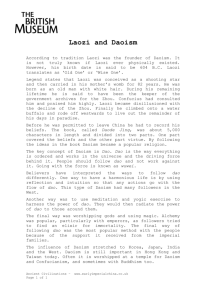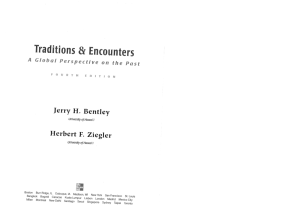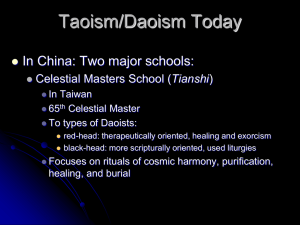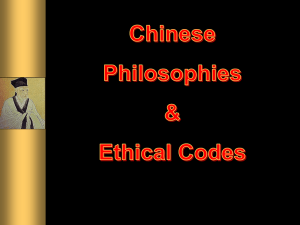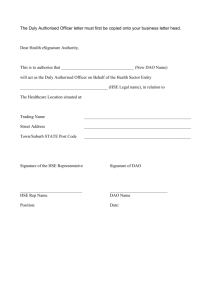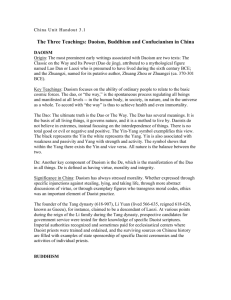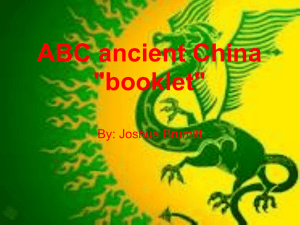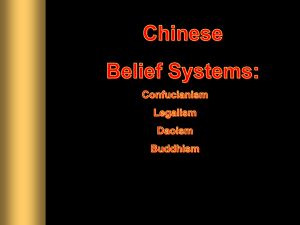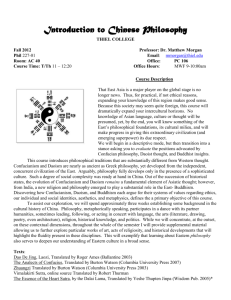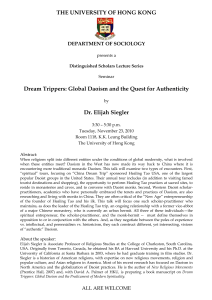3|Daoist leadership: theory and application
advertisement
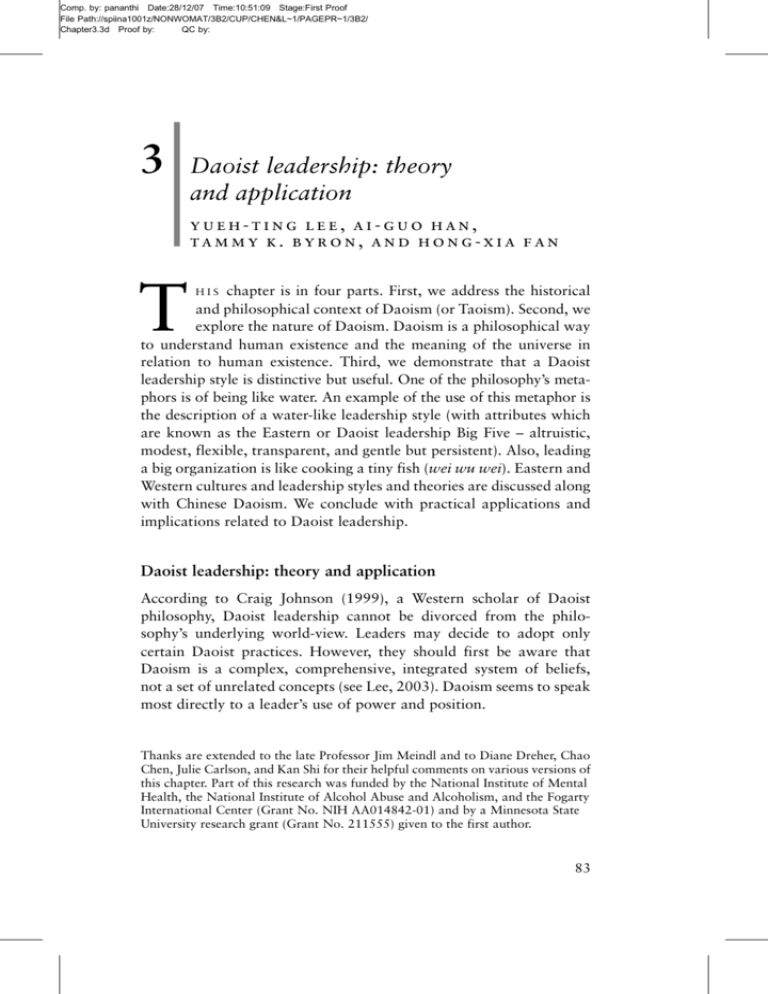
Comp. by: pananthi Date:28/12/07 Time:10:51:09 Stage:First Proof File Path://spiina1001z/NONWOMAT/3B2/CUP/CHEN&L~1/PAGEPR~1/3B2/ Chapter3.3d Proof by: QC by: | 3 Daoist leadership: theory and application yueh-ting lee, ai-guo han, tammy k. byron, and hong-xia fan T chapter is in four parts. First, we address the historical and philosophical context of Daoism (or Taoism). Second, we explore the nature of Daoism. Daoism is a philosophical way to understand human existence and the meaning of the universe in relation to human existence. Third, we demonstrate that a Daoist leadership style is distinctive but useful. One of the philosophy’s metaphors is of being like water. An example of the use of this metaphor is the description of a water-like leadership style (with attributes which are known as the Eastern or Daoist leadership Big Five – altruistic, modest, flexible, transparent, and gentle but persistent). Also, leading a big organization is like cooking a tiny fish (wei wu wei). Eastern and Western cultures and leadership styles and theories are discussed along with Chinese Daoism. We conclude with practical applications and implications related to Daoist leadership. HIS Daoist leadership: theory and application According to Craig Johnson (1999), a Western scholar of Daoist philosophy, Daoist leadership cannot be divorced from the philosophy’s underlying world-view. Leaders may decide to adopt only certain Daoist practices. However, they should first be aware that Daoism is a complex, comprehensive, integrated system of beliefs, not a set of unrelated concepts (see Lee, 2003). Daoism seems to speak most directly to a leader’s use of power and position. Thanks are extended to the late Professor Jim Meindl and to Diane Dreher, Chao Chen, Julie Carlson, and Kan Shi for their helpful comments on various versions of this chapter. Part of this research was funded by the National Institute of Mental Health, the National Institute of Alcohol Abuse and Alcoholism, and the Fogarty International Center (Grant No. NIH AA014842-01) and by a Minnesota State University research grant (Grant No. 211555) given to the first author. 83 Comp. by: pananthi Date:28/12/07 Time:10:51:09 Stage:First Proof File Path://spiina1001z/NONWOMAT/3B2/CUP/CHEN&L~1/PAGEPR~1/3B2/ Chapter3.3d Proof by: QC by: 84 Yueh-ting Lee et al. At the outset, two notes are in order. First, throughout this chapter, the standard system of Chinese pronunciation, the Pinyin system, is used for the transliteration of proper nouns from the original Chinese. Those quoted from other sources, however, may have been translated by their original authors using an alternate system. For example, Laozi, Daoism, and Dao de jing are used to replace the less accurate English expressions of Lao-tsu (or Lao-tzu), Taoism and Tao te ching. Second, Dao de jing is better known and has been translated more often than any other work except the Bible. There are many English versions of Laozi’s Dao de jing, which may be different from each other in their translations because of the philosophical and linguistic difficulty and complexity of the book. For the purpose of accurately understanding and comprehending Laozi’s ideas, this article quotes Dao de jing using the translations of Wing (1986) and Shi (1988), which provide readers with both English and Chinese versions. These authors also modified and adjusted their translations when investigating other original versions of Laozi’s Dao de jing in either modern or classic Chinese (e.g. Fei, 1984; Lao-tzu, 1993; Laozi, 1961). Thus, to the best of our knowledge, the modified translations and quotations below are consistent with Laozi’s intentions, as was verified by other research (see also Lee, 1993, 2003). The historical and philosophical context of Daoism We address two issues in this section. First, what is the historical context of Daoism in relation to other philosophies? Second, how is the philosophy of the Dao (Daoism or Dao jia) different from the worldly religion of the Dao (Dao jiao)? To understand and appreciate Daoist ideas of leadership, one must understand two major texts of Daoism, Laozi’s Dao de jing and Zhuang zi (also known as Nan Hua Jing; see Li, 1999a). Though Liezi, author of Wen shi jing (see Li, 1999b), is also considered an influential Daoist scholar, our focus will be primarily on the work of Laozi who was the pioneer of Chinese Daoism. We will refer to the ideas of Zhuangzi, another famous Chinese philosopher, where necessary. Next is an issue related to the differentiation between Dao jia and Dao jiao. Although some concepts or ideas in Daoism had existed long before his time (e.g. shamanism), Laozi has been recognized as the founder or father of Daoism. According to the famous Chinese historian Comp. by: pananthi Date:28/12/07 Time:10:51:10 Stage:First Proof File Path://spiina1001z/NONWOMAT/3B2/CUP/CHEN&L~1/PAGEPR~1/3B2/ Chapter3.3d Proof by: QC by: Daoist leadership 85 Si Ma Qian (145–86 BCE) and recent research (Lee, 1991, 2000; Sima, 1994; Yan, 1999), Laozi was born Li (or Lee) Er (Name of Laozi) around 604 BCE in Ku county of the state of the Chu, which is close to today’s Lu Yi of Henan province in the central part of China. Laozi served as the Keeper of Royal Archives for the Zhou dynasty, and, according to Si Ma Qian, Confucius, traveled from the state of Lu to visit Laozi and seek his advice. After his visit, reflecting on the profoundness of Laozi’s talk, Confucius described Laozi’s speech to his disciples: ‘‘When I met Laozi today, it was like meeting a dragon.’’ In China, a dragon is the most powerful of all species. Meeting Laozi was like meeting the most powerful person of all in the eyes of Confucius. According to historians, Laozi left his job as the Keeper of Royal Archives in 516 BCE and traveled west to the state of Qin. When he reached the pass of Han Gu Guan leading to the state of Qin, the warden of the pass, Yin Xi, persuaded Laozi to write down his teachings, now known as the book Dao de jing. According to Daoist record, Laozi stayed in Lou Guan Tai, which is southwest of today’s city of Xi An, the capital city of Shannxi province. Laozi stayed in Lou Guan Tai for some time and passed on his teachings. He then left and continued westward, traveling through the pass of San Guan and entering Shu, which is today’s Si Chuan province. Legend holds that it was here that Laozi became hermitical and lived to over a hundred years (i.e. he achieved anonymity and immortality). According to Laozi’s Dao de jing, life followed by death is nature’s course and man should follow this course calmly. This aspect of Dao de jing is known as Dao jia. The Daoist School as a religion, or Dao jiao, however, was developed much later and focuses on how to avoid death. This, of course, is against nature and Laozi’s philosophy. Thus, this chapter focuses only on Dao jia, i.e. Daoism as a philosophy or the Way of life. Daoist views of general human existence – the way of living One of the most significant aspects of Daoist views is the role of the universe or general human existence (Dreher, 1991, 1996, 2000). Daoism is a way of life and human existence in relation to the universe rather than simply an ethical or religious way of behaving. We can appreciate it more if we examine the meaning of Dao, and the Comp. by: pananthi Date:28/12/07 Time:10:51:11 Stage:First Proof File Path://spiina1001z/NONWOMAT/3B2/CUP/CHEN&L~1/PAGEPR~1/3B2/ Chapter3.3d Proof by: QC by: 86 Yueh-ting Lee et al. similarities and differences between Dao, its influence and development, and other general principles. The meaning of Dao (the Way) and De Laozi’s Daoism has two meanings. One meaning is that human beings must follow natural laws and the way it is. The other is that humans must be very humanistic or humanitarian (or de) by following human laws. The former means that humans are in harmony with nature and the latter means that they are in harmony with each other. These are the backbone of Laozi’s Daoism. More specifically, the Dao also means a road, a path, the way it is, the way of nature, the Way of Ultimate Reality, the rules/laws of nature. According to Blakney (1955), in the eyes of the Chinese, Dao does not only refer to the way the whole world of nature operates, but it also signifies the original undifferentiated Reality from which the universe has evolved. De means humanistic behavior/ virtues, character, influence, or moral force. The character de has three parts: an ideograph meaning ‘‘to go’’; another meaning ‘‘straight’’; and a pictograph meaning ‘‘the heart.’’ Together, these imply motivation by inward rectitude (Blakney, 1955: 38; Lee, 2003). In another translation (Addiss and Lombardo, 1993), Dao means a ‘‘way’’ in both literal (‘‘road’’) and metaphysical (‘‘spiritual path’’) terms. It can also, more rarely, mean ‘‘to say,’’ ‘‘to express,’’ or ‘‘to tell.’’ According to Burton Watson (Addiss and Lombardo, 1993: xiii), Dao literally means a ‘‘way’’ or ‘‘path’’ and is used by other schools of Chinese philosophy to refer to a particular calling or mode of conduct. But in Daoist writing, it has a far more comprehensive meaning, referring rather to a metaphysical first principle that embraces and underlies all being, a vast Oneness that precedes and, in some mysterious manner, generates the endlessly diverse forms of the world. Thus, it is difficult to use language to describe the Dao completely. Burton Watson (Addiss and Lombardo, 1993: xiii) defined de as the moral virtue or power that one acquires through being in accord with the Dao (Lee, 2003). What does the Dao follow? According to Laozi there is a clear hierarchy or order among humans (ren, human beings), earth (di, land), heaven (tian, sky), nature (zi ran), Comp. by: pananthi Date:28/12/07 Time:10:51:14 Stage:First Proof File Path://spiina1001z/NONWOMAT/3B2/CUP/CHEN&L~1/PAGEPR~1/3B2/ Chapter3.3d Proof by: QC by: Daoist leadership 87 and the Dao. Conceptually, as in shamanism (Lee, 2001; Lee and Wang, 2003; Wang, 2000; Xu, 1991; Yuan, 1988), earth is the Mother Nature, or yin, and is parallel to heaven, the Father Nature, or yang. Another meaning of heaven is the natural world (i.e. zi ran) outside individuals (ren). Nature can also mean the principle of nature, the way of the universe, or the way of life, including Mother Nature, Father Nature, i.e. anything external to human beings. Being very complicated, the Dao is part of nature, follows nature, and produces almost everything in the universe (i.e. is the Way), as can be seen throughout the chapters of Dao de jing. For example, in Chapter 25, it is held that the way humans act should follow or be consistent with the way earth works (ren fa di) whereas the way earth works follows or is consistent with the way heaven works (di fa tian). Also, the way heaven works follows or is consistent with the way the Dao works (tian fa dao), and the way the Dao works follows or is consistent with the way nature, or the universe, works (dao fa zi ran). In other words, Humans model themselves on earth, Earth on heaven, Heaven on the Way, And the Way on that which is naturally so. While Westerners tend to believe that humans are the center of all things or above all things, and that humans can conquer almost everything (see Fung, 1948; Johnson, 1985), Laozi’s opinion is that humans should be humble in the face of nature, the universe, or the Dao. People should follow the principles of nature and strive to conduct themselves in such ways that their behaviors are in complete harmony with the Dao. The Chinese call this optimal state tian ren he yi, which means man and external natural world (i.e. tian) are united into one. In this sense, Eastern humanism seeks the harmonious integration of human society and nature (see Lee, 2003; Lee, McCauley, and Draguns, 1999; Lee et al., 2003; Tu, 1985) and has no intention to conquer with human ambitions. What does the Dao generate? Unlike many other philosophical schools, Daoism addresses how everything in the world begins and what the meaning of life is for everything. For example, Comp. by: pananthi Date:28/12/07 Time:10:51:20 Stage:First Proof File Path://spiina1001z/NONWOMAT/3B2/CUP/CHEN&L~1/PAGEPR~1/3B2/ Chapter3.3d Proof by: QC by: 88 Yueh-ting Lee et al. The Dao produced the One. The One produced the Two. The Two produced the Three. The Three produced All Things. All Things carry Yin and hold to Yang. Their blended influence brings Harmony. (Laozi, Chapter 42)1 What did Laozi mean by the One? One which is produced by the Dao (or the natural course) means the entire universe. Two means the yin and yang, and Three means heaven, earth, and humans, which produced all things (Fei, 1984). After being created, all things in the world have their own cycle of destiny (i.e. life-time or development). For example, it is very natural for a person to be born, to grow up, to become old and senile, and finally to die. As described by Laozi, harmony means a cycle of destiny or change: Empty your mind of all thoughts, Maintain the deepest harmony. Become a part of All Things, In this way, I perceive the cycles. Indeed, things are numerous; But each cycle merges with the source. Merging with the source is called harmonizing; This is known as the cycle of destiny. The cycle of destiny is called the Absolute; Knowing the Absolute is called insight. To not know the Absolute Is to recklessly become a part of misfortune. To know the Absolute is to be tolerant. What is tolerant becomes impartial; What is impartial becomes powerful; What is powerful becomes natural; What is natural becomes Dao (Laozi, Chapter 16) As can be seen above, the Absolute may also imply regularity or universal laws. Those who comprehend regularity or universal laws are those who understand and appreciate the Dao. Comp. by: pananthi Date:28/12/07 Time:10:51:21 Stage:First Proof File Path://spiina1001z/NONWOMAT/3B2/CUP/CHEN&L~1/PAGEPR~1/3B2/ Chapter3.3d Proof by: QC by: Daoist leadership 89 The Dao means change like yin and yang The Dao is not static but dynamic as a universal principle. How does it change? Regarding the yin–yang principle, we can read the following in Laozi’s book: Polarity is the movement of the Dao. The receptivity is the way it is used. The world and All Things were reproduced from existence. Its existence was produced from nonexistence. (Laozi, Chapter 40). In other words, yin–yang reasoning is part of the Dao, and the constant change and reversal between opposites are the core movements of the Dao. When things reach one extreme, a reversal to the other extreme takes place (wu ji bi fan in Chinese, or fan zhe dao zhi dong in Laozi’s chapter 40), which is similar to a statistical regression. According to The book of change, ‘‘When the cold goes, the warmth comes; when the warmth goes, the cold comes’’ (Fung, 1948: 19), and ‘‘when the sun has reached its meridian, it declines; when the moon has become full, it wanes’’ (Fung, 1948: 19). Consistent with Daoism and The book of change, Sunzi observed in the Art of war in 550 BCE, ‘‘The thinking of the wisest leaders lies in considering both pluses and minuses. Think positively of yourself when in difficulty or in crisis; consider your weaknesses when in a strong position’’ (Sun, 1977: 79). In other words, the Dao is not static but dynamic, and it is similar to the yin–yang principle described in other Chinese philosophies. Fundamental way of living: other universal values and existence Simplicity and altruism (or serving others) are two examples of the fundamental way of living. Human beings should keep life simple and easy and try not to be too selfish. In Chapter 19, Laozi stated, ‘‘But be plain, and embrace simplicity and truth; reduce selfishness, and eschew many lusts.’’ Simplicity clears our vision, frees us from false values, and brings greater beauty to human life (Dreher, 1991: 77; Dreher, 2000: 79). Serving others and being altruistic are other general universals of human existence. This is addressed at greater length when we deal with various features of water metaphorically in the following section. Comp. by: pananthi Date:28/12/07 Time:10:51:22 Stage:First Proof File Path://spiina1001z/NONWOMAT/3B2/CUP/CHEN&L~1/PAGEPR~1/3B2/ Chapter3.3d Proof by: QC by: 90 Yueh-ting Lee et al. Based on Johnson’s (1999) work, individuals who follow the Dao (including those who are leaders): (a) exert minimal influence on the lives of followers; (b) encourage followers to take ownership of tasks; (c) employ ‘‘soft tactics,’’ such as persuasion, empowerment, modeling, teamwork, collaboration, service; (d) reject the use of violence; (e) demonstrate creativity and flexibility; (f) promote harmony with nature and others; (g) live simply and humbly; (h) reject the trappings of status and promote equality; (i) recognize the underlying spiritual dimension of reality; and (j) give to and serve others. These principles appear to provide an ethical framework for many of the latest trends in the literature: empowerment, teamwork, collaboration, servant leadership, spirituality in the workplace, and rapid innovation. Daoism and water-like (‘‘wateristic’’) leadership style The most effective way to comprehend Daoism is to focus on a metaphor that links Daoism with water (i.e. water-like, or ‘‘wateristic,’’ personality features). For Laozi, the best human qualities reflect the properties of water. We human beings, especially leaders, should learn from water because water always remains in the lowest position and never competes with other things. Instead, water is very helpful and beneficial to all things. Laozi observed that, at that time, human conflict (e.g. fighting, killing, wars) occurred very often. Less conflict might occur if everyone was less likely to compete and go after his or her interest (e.g. moving or fighting for more material, more fame, or higher rank). Thus, if we are altruistic and humble or modest, human conflict might be reduced. Why is the best like water? In his writings, Laozi used water as a metaphor many times to explain the leadership style of a sage. More specifically, water is altruistic and always serves others; water is modest, flexible, clear, soft, yet powerful (or persistent) (Lee, 2003, 2004). First, water is altruistic. All species and organisms depend on water. Without water, none of them can survive. What does water get from us? Almost nothing. A good Daoist leader should be as altruistic as water. For example, Laozi advocated a ‘‘water personality.’’ We, as human beings, including leaders, should learn from water because it always remains in the lowest position and never competes with other things. Indeed, water is very helpful and beneficial to all things. Comp. by: pananthi Date:28/12/07 Time:10:51:22 Stage:First Proof File Path://spiina1001z/NONWOMAT/3B2/CUP/CHEN&L~1/PAGEPR~1/3B2/ Chapter3.3d Proof by: QC by: Daoist leadership 91 The highest value (or the best) is like water, The value in water benefits All Things And yet it does not contend, It stays in places that others despise, And therefore is close to Dao. (Laozi, Chapter 8) Daoism recognizes that the ultimate goal of leaders is to serve their people without the desire to gain for personal benefit or to receive gratitude. Laozi stated that ‘‘The best are like water, good at benefiting all things without competing for gain’’ (Laozi, Chapter 8). This entails selflessness as an essential attribute of a leader, which is realized in accepting people’s aspirations as one’s own. ‘‘The sage does not have aspirations but adopts those of the people as his own’’ (Laozi, Chapter 49). Only when a leader does not have his own ambitions can he truly serve his people instead of competing with them. Second, water is very modest and humble. It always goes to the lowest place. As we can see from the earlier quotation (i.e. Laozi, Chapter 8), although water benefits all things, it does not contend and always stays in the lowest places that others despise. Being humble and modest is necessary for good leaders to appreciate and understand the Dao of things, and to always be ready to learn and be alert to overconfidence in the self. While many Westerners often value and enjoy a sense of authority, assertiveness, aggressiveness, and competitiveness, Laozi encouraged people to have a water-like characteristic – that is, to maintain a low profile and to be humble and modest, especially in the face of the Dao or nature, and to be very helpful and/or beneficial to others. To Laozi, modesty or humbleness, willingness to help and benefit others, and the ability to maintain a low profile (just like water) are qualities essential to a leader who wants to influence others: The rivers and seas lead the hundred streams Because they are skillful at staying low. Thus they are able to lead the hundred streams. (Laozi, Chapter 66) In Laozi’s opinion, those who are humble and modest not only exist in good harmony with others, but are effective leaders, just like the rivers and seas. The sea, for instance, can govern a hundred rivers because it has mastered being lower. Being humble is important for leaders because it Comp. by: pananthi Date:28/12/07 Time:10:51:24 Stage:First Proof File Path://spiina1001z/NONWOMAT/3B2/CUP/CHEN&L~1/PAGEPR~1/3B2/ Chapter3.3d Proof by: QC by: 92 Yueh-ting Lee et al. enables them to accept people’s goals as their own and to attract and unite people around themselves. Just as the sea accepts and embraces all rivers coming its way – muddy or clear, large or small – leaders who humble themselves before people draw people towards them and gain their trust. This does not belittle leaders, but strengthens them instead. When leaders do not discriminate against those coming their way, they will have people of all abilities around them. When they place themselves below people and praise them for their abilities, leaders will boost the self-esteem and confidence of the people, who will in return be more eager to carry out tasks to their full potentials. That is why Laozi said ‘‘He/she who knows how to motivate people acts humble. This is the virtue of no rival and uses the strength of others’’ (Laozi, Chapter 68). Third, water is very adaptable and flexible. It can stay in a container of any shape. This flexibility and fluidity lends a great deal of wisdom to leadership. Good leaders can adjust themselves to any environment and situation just as water does to a container. Lu Jin Chuan, a contemporary Daoistic master and philosopher, once said that water has no shape but that of the container (Lu, 2001: 280). Maintaining flexibility and adapting to the dynamics of change, like water following its path, are probably the best options for a leader. There is no such thing as the best leadership style or governing method across time and space in the world; rather, the best principle is being flexible and fluid, finding the appropriate way for here and now. Fourth, water is transparent and clear. Effective leaders should be honest and transparent to their followers. The most honorable individuals (not only leaders) are usually honest and transparent like water. Though Western Machiavellian or other deceptive approaches might work temporarily, being honest and transparent is one of the big ethical concerns in modern management. Water itself is very clear and transparent if you do not make it muddy. In Chapter 15, Laozi stated, ‘‘Who can (make) the muddy water clear? Let it be still, and it will gradually become clear.’’ Metaphorically, human beings by nature are naı̈ve and honest. Social environment and competition (like muddiness) make them unclear. Water’s clarity, transparency, and honesty are much appreciated by Laozi. Finally, water is very soft and gentle, but also very persistent and powerful. If drops of water keep pounding at a rock for years, even the hardest rock will yield to water. Over time, water can cut through Comp. by: pananthi Date:28/12/07 Time:10:51:25 Stage:First Proof File Path://spiina1001z/NONWOMAT/3B2/CUP/CHEN&L~1/PAGEPR~1/3B2/ Chapter3.3d Proof by: QC by: Daoist leadership 93 the hardest rock, forming valleys and canyons. The style of leaders should be similarly gentle and soft, but also persistent and powerful. Here is an example of what we could learn from water: Nothing in the world Is as yielding and receptive as water; Yet in attacking the firm and inflexible, Nothing triumphs so well. (Laozi, Chapter 78) Since there is nothing softer than water, yet nothing better for attacking hard and strong things, there is no substitute for it. Its softness enables it to tolerate all kinds of environments, gathering strength without wearing it off at an earlier stage. And the resolute and perseverance of water help it to cut its path through hard rocks and wear away mountains. It is very important for a leader to know the dialectical relationship as such and to acquire the resolute and persevering characteristics of water. In summary, water has five features which are essential to all individuals including leaders. This is what we call the Daoist model of ‘‘wateristic’’ personality (Lee, 2003, 2004; Lee et al., 2005; Watts, 1961, 1975) which includes five essential components: altruism, modesty/humility, flexibility, transparency and honesty, and gentleness with perseverance (Lee, 2003, 2004; Lee et al., 2005). This model is summarized in Figure 3.1. Leading a big organization is like cooking a tiny fish: wei wu wei As a philosophy of the way of life and beyond, Daoism intends to explain the principles of the universe and to embody all aspects of human existence and experience, including the issue of leadership. Using major principles of Daoism – zi ran (to adhere to the principle of nature), wei wu wei (practicing active non-action) – Daoist masters or sages like Laozi not only outlined the characteristics of a desirable leader, but also discussed the goals and strategies of assuming leadership roles in many aspects of human activities, from managing state affairs to cultivating the morals and virtues of individual citizens. Therefore, the analysis of Daoist notions about leadership can be a valuable source of information for many. Comp. by: pananthi Date:28/12/07 Time:10:51:25 Stage:First Proof File Path://spiina1001z/NONWOMAT/3B2/CUP/CHEN&L~1/PAGEPR~1/3B2/ Chapter3.3d Proof by: QC by: 94 Yueh-ting Lee et al. Modest and humble: deference or yielding Flexible and adjustable Altruistic: water is altruistic and helpful Daoist Big Five: water-like characteristics or personality features Transparent (or clear) and honest Gentle but persistent Dao De Harmony with other human beings, and harmony with the natural world/universe Laozi and Daoism in Ancient China Figure 3.1. The Daoist model of wateristic personality (Daoist Big Five). In the opinion of Laozi and many other Daoists, leaders are those sheng ren (or sages or saints) who are actually no more than servants or followers (see Li and Zhu, 2001; Zhu, 1999). The more one serves, the more one leads. Leadership first means follower-ship or serviceship just like water. Second, leadership mean non-intrusiveness or non-interference (by practicing wu wei or by following natural laws or Dao), and it also refers to change, as discussed at length below. Laozi strongly emphasized the principle of wei wu wei, or ‘‘spontaneity and the natural way’’ throughout his book. ‘‘Wei (follow or do) Wu-Wei (without doing or without action; wu¼not)’’ adheres to the principle of ‘‘noninterference’’ in the natural course of things or events, allowing things to be or to act within the true nature of the Dao. Wu wei ‘‘flows naturally from the holistic vision of Tao’’ (Dreher, 1991: 213; Dreher, 2000: 223). For example, if individuals Comp. by: pananthi Date:28/12/07 Time:10:51:28 Stage:First Proof File Path://spiina1001z/NONWOMAT/3B2/CUP/CHEN&L~1/PAGEPR~1/3B2/ Chapter3.3d Proof by: QC by: Daoist leadership 95 see themselves as part of the larger whole, they cooperate with the rhythms of life. According to Chinese research on leadership (Ge, 1994), wei wu wei has three meanings, or principles, with regard to governance or leadership. Principle 1 is ‘‘doing something while not doing something else.’’ Principle 2 is noninterference or following a natural course. Principle 3 is symbolic leadership or governance. For example, the following is consistent with Principle 1: The Dao never acts, And yet is never inactive. (Laozi, Chapter 37) To pursue artificial discovering (to learn), add to it daily, To pursue the Dao, subtract (interfere less) from it daily Subtract and subtract again, To arrive at non-action. Through non-action nothing is left undone. (Laozi, Chapter 48) Act without action; work without effort. Taste without savoring. Magnify the small; increase the few. Repay ill-will with kindness. Plan the difficult when it is easy; Handle the big where it is small. The world’s hardest work begins when it is easy; The world’s largest effort begins where it is small. Evolved/Wise Individuals (or Sages/Saints), finally take no great action, And in that way the great is achieved. (Laozi, Chapter 63) As can be seen above, wei wu wei does not mean being inert, lazy, or passive. Based on counseling and psychotherapy research (Knoblauch, 1985; Maslow, 1971, 1998; Watts, 1975), noninterference can be helpful and important in certain circumstances. For example, too much care or being too concerned for other people or clients (or things) may lead to too much intervention or control. It is important and necessary that Daoistic leaders be aware that too much action or intervention in the affairs of other humans (or things) may produce opposite or negative outcomes (e.g. in counseling or management). As was discussed previously, man follows earth which follows heaven; Comp. by: pananthi Date:28/12/07 Time:10:51:28 Stage:First Proof File Path://spiina1001z/NONWOMAT/3B2/CUP/CHEN&L~1/PAGEPR~1/3B2/ Chapter3.3d Proof by: QC by: 96 Yueh-ting Lee et al. heaven follows the Dao which follows nature. This means that we should be natural, and should not intervene too much – wei wu wei. In Chapter 60 of the Dao de jing, Laozi wrote, ‘‘Leading a large organization or state is like cooking a small fish.’’ In other words, in order to support an organization or state, a leader must follow the Dao by ‘‘cooking a small fish’’ appropriately. Just as too much stirring will cause a delicate fish to fall apart, too much interference will unbalance the situation and one’s place within it (Wing, 1986). The major concern of leaders is to cultivate the Dao in organizational affairs (e.g. adding flavor to the fish and taking care of the temperature and cooking time) and to allow natural forces, the Dao, to produce problems and point the way toward solutions by themselves. Cooking a small fish is just an example of wei wu wei, which is consistent with Principles 1 and 2 above. Primarily based on Principle 2, wei wu wei means ‘‘going with the grain, rolling with the punch, swimming with the current, trimming the sails to the wind, taking the tide at its flood, and stooping to conquer’’ (Watts, 1975: 75). It is the flow or well-being that allows one to be in harmony with all things or people, which is similar to the Western religious saying, ‘‘Letting God be God in you.’’ Wei wu wei (practicing positive inaction) also means letting events take their own course of complying with the forces of nature. There is an excellent example of swimming with the current. Zhuangzi (or Chuang-tzu) illustrated the power of wei wu wei in a story in which an old man fell into a great waterfall. By the time rescuers reached him, he had already climbed back onto the bank. When asked how he survived his ordeal, the gentleman replied: ‘‘I go down with the swirls and come up with the eddies, following along the way the water goes and never thinking about myself. That is how I can stay afloat’’ (Johnson, 1999, 2000). In the physical world many things move and change, but underlying principles remain the same. Therefore, leaders should be able to observe fundamental principles while adapting to change. It is essential for leaders to reconcile between wu wei er zhi (doing nothing to interfere with the natural course and things will settle themselves) and you wei er zhi (making an effort and things will change with it), two seemingly contradictory approaches that are both present in Laozi’s book, Dao de jing, which are consistent with Principles 1 and 2. Comp. by: pananthi Date:28/12/07 Time:10:51:30 Stage:First Proof File Path://spiina1001z/NONWOMAT/3B2/CUP/CHEN&L~1/PAGEPR~1/3B2/ Chapter3.3d Proof by: QC by: Daoist leadership 97 For example, in Chapter 57 Laozi stated, ‘‘When I do nothing, people will transform themselves. When I remain still, people will adjust themselves. When I do nothing, people will prosper themselves. When I do not desire, people will simplify their lives.’’ Here he clearly advocated doing nothing to intervene in leadership style. On the other hand, he emphasized early preventative action (i.e. to be proactive): ‘‘It is easy to maintain it while it is peaceful. It is easy to deal with it before it materializes. It is easy to break it while it is fragile. It is easy to disperse it while it is tiny. Take action before it comes into existence and govern before it rebels’’ (Laozi, Chapter 64). This is consistent with Principle 1. According to Daoism, while too much interference is not good, not taking action when needed is equally problematic. Consistent with Principle 3 (symbolic leadership or governance), Laozi wrote with regard to wei wu wei: When the Master governs, the people Are hardly aware that he exists. Next best is a leader who is loved. Next, one who is feared. The worst is one who is despised. If you don’t trust the people, You make them untrustworthy. The Master doesn’t talk, he [she] acts. When his [her] work is done, The people say, ‘‘Amazing: We did it, all by ourselves!’’ (Laozi, Chapter 17) First, according to research by Ge (1994), a philosopher now in China, ‘‘when the Master governs, the people are hardly aware that he is leader.’’ In other words, the leader leads strategically without micromanaging his or her followers, lets his followers do their work, and does not interrupt what they do naturally. The Master here implies sheng ren (or sage) whose style is to follow Dao or the natural course (noninterference). Second, according to Ge (1994), ‘‘next best is a leader who is loved,’’ which means the leader whose style is to follow de (leading people based on their needs – i.e. humanistic). Third, ‘‘next, one who is feared’’ which means relying solely on fa, that is rules and regulations and punishment. Finally, ‘‘the worst is one who is despised’’ which means the leaders who are not only incompetent, but Comp. by: pananthi Date:28/12/07 Time:10:51:32 Stage:First Proof File Path://spiina1001z/NONWOMAT/3B2/CUP/CHEN&L~1/PAGEPR~1/3B2/ Chapter3.3d Proof by: QC by: 98 Yueh-ting Lee et al. also do not follow any Dao, de or fa. Thus, their followers despise them. The first of these, Dao-based leadership is an example of wei wu wei leadership, which is the best (see also Fan and Zhu, 2003; Ge, 1994). Applications and implications Chinese cases related to Daoism Here are several examples of Daoistic leadership, management, and conflict resolution. The first case is that of Zhou Gong Dan. About 3200 years ago, Zhou Gong Dan assisted his brother King Wu in defeating the Shang dynasty (Sima, 1994). When King Wu passed away, his son and successor, King Cheng, was too young to rule, so Zhou Gong Dan served as regent. He managed the nation very well, but when King Cheng grew up, Zhou Gong Dan stepped aside and let King Cheng exercise full control of state affairs. In the opinion of Laozi and Kongzi (or Confucius), Zhou Gong Dan was a typical sheng ren (or sage or saint) because, just like water, he was humble and served the interest of the nation instead of his own desires or interests (Sima, 1994). Wei wu wei’s Daoism was also followed and practiced in the Han and Tang dynasties (Ai, 1996). About 2000 years ago, China was in chaos after years of warfare. Cao Can, a statesman in the Han dynasty, followed Daoism and let people work for their living without any taxation or without drafting them to any big governmental projects. In the Han dynasty, one of the emperors was Wen Jing. He practiced Daoism so well in his leadership that during his tenure, people were very happy and society was very prosperous. The society was peaceful, and people were happy and well fed. It was called ‘‘Wen Jing Days’’ (Xiong and Yuan, 1999). In the Tang dynasty (about 1400 years ago), Emperor Li Shi Ming also followed Daoism as the state ideology. He redistributed the land-holdings among the Chinese people and had an ‘‘in-kind’’ system of minor taxation whereby farmers could pay in goods or food. This period is historically called the Happy Days of ‘‘Zhen Guan’’ (the Year of his Governance) in which everything was in harmony and everyone was happy (Wing, 1986). Moreover, Li Shi Ming was very careful about his own behavior as leader. He was open to others’ advice and learned from history. Comp. by: pananthi Date:28/12/07 Time:10:51:36 Stage:First Proof File Path://spiina1001z/NONWOMAT/3B2/CUP/CHEN&L~1/PAGEPR~1/3B2/ Chapter3.3d Proof by: QC by: Daoist leadership 99 Among his recorded sayings, the best known is, ‘‘By using a mirror of brass, you may see to adjust your cap and clothes; by using antiquity as a mirror, you may learn to foresee the rise and fall of empires; and by using others as your mirror, you will learn about your own strengths and weaknesses’’ (Wing, 1986: 52–53). Another case is that of Xue Yong Xin and his En Wei Corporation, a Chinese skincare product manufacturer (Xue, 2003). Xue Yong Xin uses Daoism to educate his employees on a weekly basis. Specifically, their slogan is not to compete against other companies, but to serve people by filling the market niche. To serve people, one of their most reputable products is Ji Er Yin which is used as a very effective Chinese medicine to clean skin. Today En Wei is one of China’s top twenty private and successful corporations. As CEO of the company, Xue Yong Xin says that both he and the corporation strictly follow Laozi’s Daoism (Xue, 2003). Burton’s case Daoism can also be used to build a harmonious relationship between a leader and a follower (i.e. conflict resolution). For example, Robert Rosen made a cogent case that twenty-first-century success will belong to CEOs who develop a ‘‘global mindset’’ that goes beyond the limits of any single country’s culture or approach. Daoism may challenge people to go beyond ‘‘either–or’’ thinking to achieve ‘‘both–and’’ thinking. The following case is illustrative (Burton, 2000): An association CEO found herself with a seemingly unsolvable dilemma. Her new president, whose company recently dominated the industry, asked her to do something blatantly unethical: use association funds to pay for travel of his four top Latin American customers to the association’s trade show. Her supporters on the board secretly advised her to comply because they felt their businesses would be at risk; the association’s attorney advised her to go along – after all, what he was suggesting wasn’t ‘‘illegal.’’ What to do? She could make a grand stand and lose her job – the president had already subtly threatened her on another occasion – or she could comply but lose her soul. It was a clear either–or dilemma. She chose non-action – first, by deliberately not responding for several days and, second, by meditating on the situation. She stilled her mind; she allowed her outrage to dissolve. An hour later in the meditation, she heard the words, ‘‘Turn it on its head.’’ She had it! These four individuals could put on a seminar about trade issues Comp. by: pananthi Date:28/12/07 Time:10:51:37 Stage:First Proof File Path://spiina1001z/NONWOMAT/3B2/CUP/CHEN&L~1/PAGEPR~1/3B2/ Chapter3.3d Proof by: QC by: 100 Yueh-ting Lee et al. in Latin America. The association needed an international focus: why not start with Latin America? The resulting program was the genesis of a major international initiative. Going beyond either–or thinking (and the self-righteousness that accompanies a ‘‘right’’ and ‘‘wrong’’ approach) and cultivating ‘‘non-action’’ enabled her to act within her ethical limits and develop something new and creative. From the above case, there are at least two implications from the practice of Daoistic leadership style. First, sometimes it is wise to decide not to act (i.e. positive non-action). Time and patience (i.e. wei wu wei) are important characteristics of Daoistic leaders. Second, Western leadership thinking is based on an either–or style while Daoism is holistic, or both–and. The Western approach is that you cannot have it both ways. However, the Daoistic style is that you can have both. Research has shown a difference between the East and West in reasoning styles, which will be illustrated in greater detail in the part that follows. According to Peng and Nisbett (1999), Western thinking or reasoning is more Aristotelian, while Chinese thinking is more dialectical. Patterns of causal attribution and conflict resolution can vary tremendously from culture to culture (Lee and Seligman, 1997; Nisbett et al., 2001; Takaku, Weiner, and Ohbuchi, 2001). Recent studies by Richard Nisbett and his colleagues (2001) showed that the East Asian view of causality is holistic, marked by a tendency to attend to the entire field when making causal attributions. This way of viewing causality has been labeled dialectical reasoning (or yin–yang thinking as by Lee, 2000). It includes the principles of change, contradiction, and interrelation based on Chinese Daoism or traditional culture. For example, an unpleasant situation can become a peaceful one (i.e. change); a conflict can be viewed as something positive (i.e. contradiction); and any problem or dilemma involves two parties (i.e. interrelation). Thus, it is safe to assume that some conflict situations become very difficult to resolve because of a tendency of both parties to perceive victims and wrongdoers as separate entities. They hold that if one is a wrongdoer he or she cannot be anything other than a wrongdoer. The same holds true for their perception of a victim. If both parties involved in a conflict were to follow the principles of Eastern dialectical reasoning, however, these conflict situations could be resolved more easily (Takaku et al., 2003; Takaku, Weiner, and Ohbuchi, 2001). Daoistically, ‘‘it takes two to tango,’’ or ‘‘one hand cannot clap.’’ Comp. by: pananthi Date:28/12/07 Time:10:51:37 Stage:First Proof File Path://spiina1001z/NONWOMAT/3B2/CUP/CHEN&L~1/PAGEPR~1/3B2/ Chapter3.3d Proof by: QC by: Daoist leadership 101 Leadership based on Theory X, Theory Y vs. Daoistic humanism Western management theories often neglect the benefits of Daoism. The common Western leadership theory, Theory X, was developed by Douglas McGregor (1960, 1966). It is a traditional management approach that emphasizes control and compliance. Specifically, managers or leaders make a number of assumptions, such as: subordinates or followers dislike work and consequently will avoid it; they do not or will not accept responsibility; they are not ambitious and desire to be led; and they must be closely supervised if organizational goals are to be attained (see also Miller, Catt, and Carlson, 1996: 326–327). McGregor developed another theory, known as Theory Y. This stresses management or leadership through input, collaboration and delegation. According to Theory Y, people want to work, they are willing to accept responsibilities, and they are ambitious and demonstrate initiative to achieve an objective. People can attain goals with positive motivation. Based on McGregor’s Theory X and Theory Y, William Ouchi (1981) developed Theory Z and Abraham Maslow (1970) developed humanistic or hierarchical need theory. Theory Z, as proposed by Ouchi, combines the best parts of both Japanese and American firms and focuses on sharing, collaboration, trust, teamwork, and inclusive decision-making, which is in line with Daoistic management or leadership. Similarly, Maslow’s approach also focuses on human dignity and self-actualization, and was much influenced by Daoism and Native American culture (see Maslow, 1998). According to Lee (2003), Maslow is not only a great humanistic psychologist, but also a great Daoist. In his books Motivation and personality (1970) and The farther reaches of human nature (1971), Maslow cites the concept Daoism/Daoistic numerous times. Maslow’s being values and perception/cognition are also based on Daoism (Maslow, 1971: 129). Daoistic listening is much appreciated and emphasized in his writing. In one of his bestsellers, Eupsychian management, Maslow (1965) expressed displeasure with ‘‘the materials on leadership in the management literature’’ (p. 122) that focus on McGregor’s Theory X or Y rather than functional leadership: The kind of B-leadership [i.e. Being leadership] which would emerge would be the same kind of functional leadership that I saw in the Blackfoot Comp. by: pananthi Date:28/12/07 Time:10:51:38 Stage:First Proof File Path://spiina1001z/NONWOMAT/3B2/CUP/CHEN&L~1/PAGEPR~1/3B2/ Chapter3.3d Proof by: QC by: 102 Yueh-ting Lee et al. Indians, or that I see in a group of youngsters who form a basketball team, perhaps, and who have good team spirit and who are not selfish prima donnas. The Blackfoot Indians tended not to have general leaders with general power, for instance, like our President of the United States, but rather had different leaders for different functions. For instance, . . . in any group of hundreds of people, we should not expect that the person who is best suited to arrange the Sun Dance must be exactly the same person who is best suited to be the political representative to the Canadian government . . . Another aspect of B-leadership in the Blackfoot was that the leader had absolutely no power whatsoever that wasn’t deliberately and voluntarily given to him ad hoc by the particular people in the particular situation. That is to say, he didn’t really influence anyone or order anyone about (Maslow, 1965: 123–124). Maslow’s leadership model above is similar to Fiedler’s contingency model (1967) that holds that any individual’s leadership style is effective only in certain situations. For another, Maslow’s eupsychian leadership style is very daoistic or wateristic – it is characterized by refraining from giving orders and having no power (but being modest and gentle). In brief, we can observe direct connections between humanistic psychology and Daoism through Maslow’s work. In summary, Daoism is very complex, and this chapter provides only a preliminary overview of Daoism and Daoistic leadership perspectives, including its historical and philosophical context, its general/universal approach to human existence, the idea of water-like (or wateristic) personality (or leadership style), and the wei wu wei approach as well as its application. But what are its implications? First, rediscovering the meaning of Dao and de is still useful in management and leadership studies. Times may change, but human nature remains largely unchanged. In fact, Maslow was one of the very few researchers in management and psychology who realized and appreciated the value and significance of Daoism. Though Daoist leadership was briefly touched on by Maslow (1971), mainstream management scientists pay little attention to Maslow’s work (see Drucker, 2001: 77), which is a major regret in the field of leadership and management. Reintroducing Laozi and Daoism to the leadership and management field will broaden its research outlook not only in the specific academic discipline, but also in the social and behavioral sciences in general (Lee, 2003). Second, Daoism may help leaders to lead more effectively and happily in the practical world. Most managers and leaders in the West Comp. by: pananthi Date:28/12/07 Time:10:51:38 Stage:First Proof File Path://spiina1001z/NONWOMAT/3B2/CUP/CHEN&L~1/PAGEPR~1/3B2/ Chapter3.3d Proof by: QC by: Daoist leadership 103 behave and function on the basis of Western philosophy or religious beliefs. Eastern philosophy or beliefs (e.g. Daoism) may complement what is missing in the West and help managers and leaders function more effectively and with more satisfaction (see also the parables of leadership by Kim and Mauborgne, 1992). Third, the theoretical research on Daoist leadership here may throw some light on empirical investigations in management science and social and behavioral sciences. For example, much research suggests that leaders who display self-sacrificial altruistic behavior lead their followers more effectively than those without self-sacrificial altruism (Choi and Mai-Dalton, 1998, 1999; van Knippenberg and van Knippenberg, 2005), which is consistent with our Daoist wateristic model. It is hoped that this chapter provides management researchers and scholars with some theoretical ideas to test Daoist perspectives in their future research. Fourth, studying Daoism theoretically may help us to reduce ecological problems and human conflict. Following Dao and de may help us to be peaceful and in harmony with Mother Nature and other human beings. In this day and age, the world is like a small village and human issues, such as interpersonal and intergroup/ cultural relationships, ethnic conflict or ethnic cleansing, hate crimes, discrimination against females or minorities, violence against women, and ecological/environmental ones are major concerns for all global citizens. Perhaps Daoism may be useful and valuable to most global citizens, including those leaders who understand and appreciate Laozi’s Dao and de. Finally, some Chinese scholars and managers are so preoccupied with Western management theories and applications that they have paid little attention to Daoistic leadership style (see the review by Li and Zhu, 2001). Rediscovering and promoting Daoism will not only enhance research in Chinese management but also help to apply Daoism to Chinese management and leadership style in a way that is more effective than the Western Theory X or Theory Y. Because Daoism is part of the Chinese traditional culture and belief systems, it is much easier for Chinese scholars and CEOs to learn, practice, and benefit from it. Besides, Chinese scholars and leaders must develop their own identity in research and its application to leadership. Perhaps Daoistic leadership is one area where they can start. Although this may pose major challenges and difficulties for some Chinese scholars Comp. by: pananthi Date:28/12/07 Time:10:51:39 Stage:First Proof File Path://spiina1001z/NONWOMAT/3B2/CUP/CHEN&L~1/PAGEPR~1/3B2/ Chapter3.3d Proof by: QC by: 104 Yueh-ting Lee et al. and managers because little has been done in this endeavor, we must begin now to achieve its great promise. As Laozi stated in Chapter 64, ‘‘A journey of a thousand miles begins with a single step.’’ Note 1 Throughout this chapter, quotations of Laozi’s Dao de jing are taken from Wing’s (1986) translation. References Addiss, S., and Lombardo, S. 1993. Lao-Tzu Tao Te Ching. (trans.) (introduced by Burton Watson). Indianapolis, IN: Hackett. Ai, Qi 1996. ‘‘Dao jia de wu wei ling dao si xiang’’ (Ideas of Daoist Wu-Wei leadership), Leadership Sciences 5: 43–44. Blakney, R. B. 1955. The way of life: Lao Tzu (a new translation of the Tao Te Ching). New York: New American Library. Burton, S. 2000. ‘‘The Tao of leadership: beyond action and non-action,’’ www.gwsae.org/ExecutiveUpdate/2000/August/Tao.htm Choi, Y., and Mai-Dalton, R. R. 1998. ‘‘On the leadership function of self-sacrifice,’’ Leadership Quarterly 9: 475–501. 1999. ‘‘The model of followers’ responses to self-sacrificial leadership: an empirical test,’’ Leadership Quarterly 10: 397–421. Dreher, D. 1991. The Tao of inner peace: a guide to inner and outer peace. New York: HarperCollins. 1996. The Tao of personal leadership. New York: HarperCollins. 2000. The Tao of inner peace. New York: Penguin Books. Drucker, P. 2001. The essential Drucker. New York: HarperCollins. Fan, T. W., and Zhu, Y. X. 2003. ‘‘On Taoist managerial psychological thoughts,’’ Advances in Psychological Sciences 11(1): 116–119. Fei, W.-Z. 1984. Investigating and editing Laozi’s Dao De Jing. Taipei: Meizhi Library Press. Fiedler, F. 1967. A theory of leadership effectiveness. New York: McGraw-Hill. Fung, Y.-L. 1948. A short history of Chinese philosophy. New York: Free Press. Ge, R. J. 1994. ‘‘Dao jia wu wei er zhi de si xiang dui xian dai guan li de qi shi’’ (Daoist wu-wei’s governance helps in modern management), New Perspective 4: 51–54. Hsu, P. S. S. 1981. Chinese discovery of America. Hong Kong: Southeast Asian Research Institute. Johnson, C. E. 1999. ‘‘Emerging perspectives in leadership ethics,’’ www. academy.umd.edu/ila/Publications/Proceedings/1999/cjohnson.pdf Comp. by: pananthi Date:28/12/07 Time:10:51:42 Stage:First Proof File Path://spiina1001z/NONWOMAT/3B2/CUP/CHEN&L~1/PAGEPR~1/3B2/ Chapter3.3d Proof by: QC by: Daoist leadership 105 2000. ‘‘Taoist leadership ethics,’’ Journal of Leadership Studies 7(1): 82–91. Johnson, F. 1985. ‘‘The Western concept of self,’’ in A. J. Marsella, G. DeVos, and F. L. K. Hsu (eds.), Culture and self: Asian and Western perspectives, New York: Tavistock Publications, pp. 91–138. Kim, W. C., and Mauborgne, R. A. 1992. ‘‘Parables of leadership,’’ Harvard Business Review 70: 23–128. Knoblauch, D. 1985. ‘‘Applying Taoist thought to counseling and psychotherapy,’’ American Mental Health Counselors Association Journal, Special issues on attitudes toward counseling and mental health in non-Western societies, 7(2): 52–63. Lao-tzu 1993. Tao te ching, introduced by B. Watson, trans. by S. Addiss and S. Lombardo. Indianapolis, IN: Hackett. Laozi 1961. Laozi’s Dao de jing. Its notation by Wang Bi in the Jin Dynasty [c. 150 CE] and review by Yan Fu in the Qing dynasty [c. 1800 CE]. Taipei: Kuang Wen Press (in Chinese). Lee, Y.-T. 1991. ‘‘Psychological theories in Ancient China: a historical view.’’ Paper presented at the 99th Annual Convention of the American Psychological Association, San Francisco. 1993. ‘‘Psychology needs no prejudice but the diversity of cultures,’’ American Psychologist 48: 1090–1091. 2000. ‘‘What is missing on Chinese–Western dialectical reasoning?’’, American Psychologist 55: 1065–1067. 2001. ‘‘‘Unique’ similarities between Ancient Chinese and Native American cultures: paleo-psychological beliefs and cultural meanings beyond time and space.’’ Paper presented at the Annual Conference of the Association of Chinese Social Scientists (in USA) at University of Bridgeport, October 26–27. Bridgeport, CT. 2003. ‘‘Daoistic humanism in ancient China: broadening personality and counseling theories in the 21st century,’’ Journal of Humanistic Psychology 43(1): 64–85. 2004. ‘‘What can chairs learn from Daoistic/Taoistic leadership? An Eastern perspective,’’ The Department Chair 4(4): 25–32. Lee, Y.-T., McCauley, C. R., and Draguns, J. 1999. Personality and person perception across cultures. Mahwah, NJ: Lawrence Erlbaum Associates. Lee, Y.-T., McCauley, C. R., Moghaddam, F., and Worchel, S. 2003. Psychology of ethnic and cultural conflict: looking through American and global chaos or harmony. Westport, CT: Greenwood. Lee, Y.-T., Norasakkunkit, V., Liu, Li, Zhang, J., and Zhou, M. 2005. ‘‘Taoist altruism and wateristic personality: East and West.’’ Paper presented at the 34th Annual Conference of the Society for CrossCultural Research, February 23–27, Santa Fe, NM. Comp. by: pananthi Date:28/12/07 Time:10:51:43 Stage:First Proof File Path://spiina1001z/NONWOMAT/3B2/CUP/CHEN&L~1/PAGEPR~1/3B2/ Chapter3.3d Proof by: QC by: 106 Yueh-ting Lee et al. Lee, Y.-T., and Seligman, M. E. P. 1997. ‘‘Are Americans more optimistic than the Chinese?,’’ Personality and Social Psychology Bulletin 23: 32–40. Lee, Y.-T., and Wang, D. 2003. ‘‘Aboriginal people in Taiwan, Continental China and the Americas: ethnic inquiry into common root and ancestral connection,’’ in X. B. Li and Z. Pan (eds.), Taiwan in the TwentyFirst Century, Lehman, MD: University Press of America. Li, A. G. 1999a. Zhuangzi’s Nan Hua Jing. Beijing: Chinese Social Press (in Chinese). 1999b. Liezi’s Wen Shi Jing. Beijing: Chinese Social Press (in Chinese). Li, Y., and Zhu, Y. X. 2001. ‘‘Ideas of wu wei and management and modern values,’’ unpublished manuscript, Jiangsu University. Lu, J. C. 2001. Yuan rong de tai ji miao li: Hua sheng, dui dai, liu xing (Tai ji: a seamless theory about life, relativity, and change). Taipei: Third Nature. Maslow, A. 1965. Eupsychian management: a journal. Homewood, IL: Richard Irwin. 1970. Motivation and personality. New York: Harper & Row. 1971. The farther reaches of human nature. New York: Viking Press. 1998. Maslow on management (with D. C. Stephens and G. Heil). New York: Wiley. McGregor, D. 1960. The human side of enterprise. New York: McGraw-Hill. 1966. Leadership and motivation. Cambridge, MA: MIT Press. Miller, D. S., Catt, S. E., and Carlson, J. R. 1996. Fundamentals of management: a framework for excellence. Minneapolis–St. Paul, MN: West. Nisbett, R., Peng, K., Choi, I., and Norenzavan, A. 2001. ‘‘Culture and systems of thought: holistic versus analytic cognition,’’ Psychological Review 108(2): 291–310. Ouchi, W. 1981. Theory Z. Reading, MA: Addison-Wesley. Peng, K., and Nisbett, R. E. 1999. ‘‘Culture, dialectics, and reasoning about contradiction,’’ American Psychologist 54: 741–754. Shi, J. 1988. Selected readings from famous Chinese philosophers. Beijing: People’s University of China Press. Sima, Q. 1994. ‘‘Shi ji’’ (original work c. 150 BCE), in Records of the Grand Historian of China, Yin-Chuan: Ninxia People’s Press. Sun, Tsu 1977. Sunzi binfa (The art of war, c. 550 BCE). Beijing, China: Book Bureau. Takaku, S., Lee, Y.-T., Weiner, B., and Ohbuchi, K. 2003. A cross-cultural examination of people’s perceptions of apology, responsibility, and justice: The U.S.S. Greenville accident and the EP-3 airplane accident. Los Angeles: Soka University of America. Takaku, S., Weiner, B., and Ohbuchi, K. 2001. ‘‘A cross-cultural examination of the effects of apology and perspective taking on forgiveness,’’ Journal of Language and Social Psychology 20: 144–166. Comp. by: pananthi Date:28/12/07 Time:10:51:53 Stage:First Proof File Path://spiina1001z/NONWOMAT/3B2/CUP/CHEN&L~1/PAGEPR~1/3B2/ Chapter3.3d Proof by: QC by: Daoist leadership 107 Tu, W.-M. 1985. ‘‘The selfhood and otherness in Confucian thought,’’ in A. J. Marsella, G. DeVos and F. L. K. Hsu (eds.), Culture and self: Asian and Western perspectives, New York: Tavistock, pp. 231–251. van Knippenberg, B., and van Knippenberg, D. 2005. ‘‘Leader self-sacrifice and leadership effectiveness: the moderating role of leader prototypicality,’’ Journal of Applied Psychology 90(1): 25–37. Wang, D. Y. 2000. The times of Shan Huang Wu Di. Beijing: Chinese Society’s Press (in Chinese). Watts, A. W. 1961. Psychotherapy East and West. New York: Pantheon. 1975. Tao: the watercourse way. New York: Pantheon. Wing, R. L. 1986. The Tao of power: a translation of the Tao Te Ching by Lao Tzu. Garden City, NY: Doubleday. Xiong, L. H., and Yuan, Z. G. 1999. Laozi and modern management. Beijing: Xuelin (in Chinese). Xu, X. Z. 1991. The origin of the book Shan Hai Jing. Wuhan: Wuhan (in Chinese). Xue, Y. X. 2003. ‘‘Da Dao Wu Wei,’’ http://dd.sharebook.net/main.htm. Yan, L.-S. 1999. ‘‘Dao De Jing xin li xue sixiang: jingshen jieyue lun’’ (Psychological ideas in Dao De Jing: conservation of psychological energy), Academic Bulletin of Social Sciences at Hunan Teaching University 28(1): 116–121. Yuan, K. 1988. Chinese History of Mythology. Shanghai: Shanghai Literature Publishing House (in Chinese). Zhu, Y. X. 1999. Chinese management wisdom. Jiangsu: Suzhou University Press.
